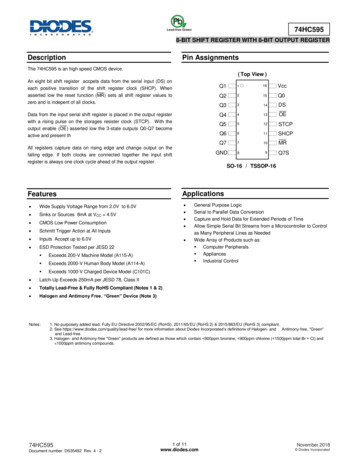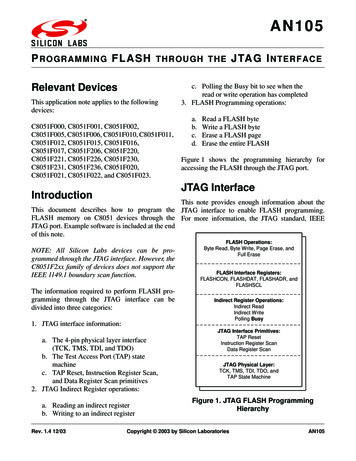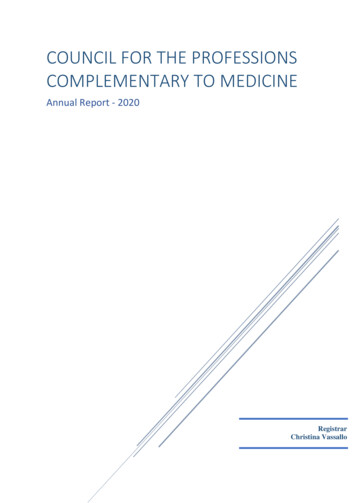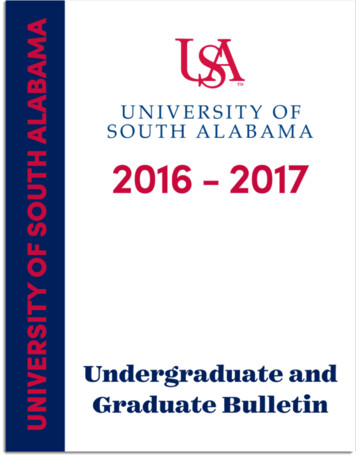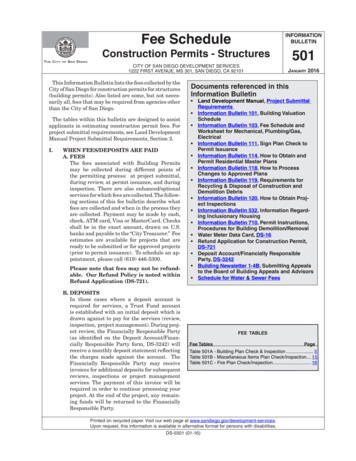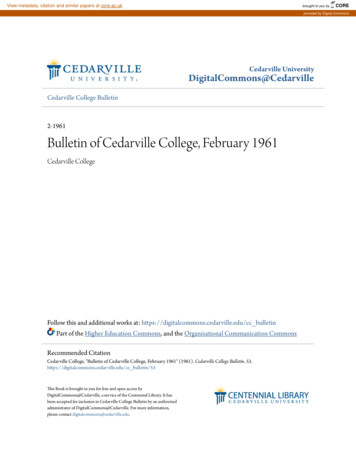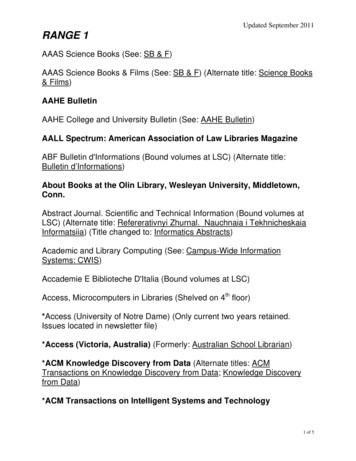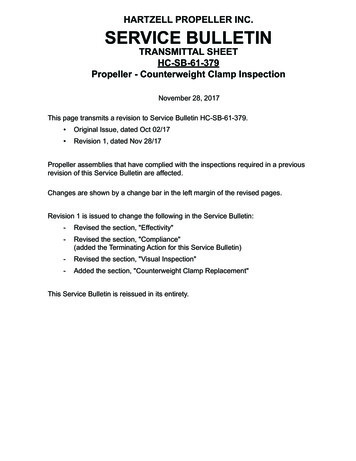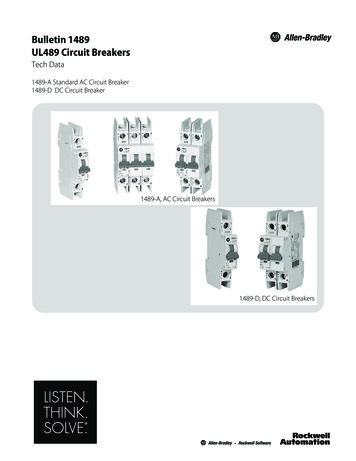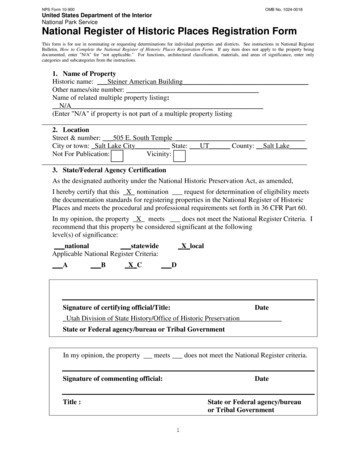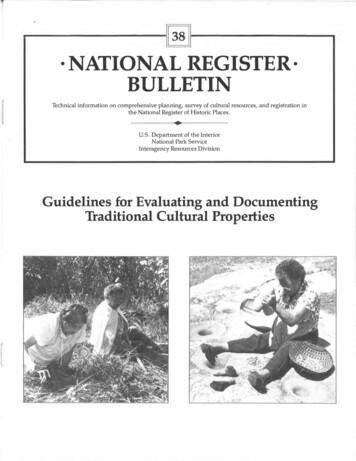
Transcription
. NATIONAL REGISTER·BULLETINTechnical information on comprehensive planning, s urvey of cultural resources, and registration inthe National Register of Historic Places.U.S. Department of the InteriorNational Park ServiceInteragency Resources DivisionGuidelines for Evaluating and DocumentingTraditional Cultural Properties
As the 1'J:ation's principal conservationagency, the Department of the Interiorhas responsibility for most of ournationally owned public lands and natu ral resources. This includes fostering thewisest use of our land and waterresources, protecting our fish and wild life, preserving the environmental andcultural values of our nation parks andhistorical places, and providing for theenjoyment of life through outdoor recre ation. The Department assesses ourenergy and mineral resources and worksto assure that their development is in thebest interests of all our people. TheDepartment also has a major responsi bility for American Indian reservationcommunities and for people who live inisland territories under U.S. administra tion.Cover photographs:Many traditional cultural properties areused for practical purposes by thosewho value them. This sedge preserve innorthern California, for example, istended and harvested by Pomo Indianbasketmakers as a vital source of mate rial for making their world famous bas kets. The preserve was established atLake Sonoma by the U.S. Army Corpsof ,Engineers. (Richard Lerner)This bedrock mortar in central Califor nia plays an essential role in processingBlack Oak acorns. (Theodoratus Cul tural Research)
Guidelines for Evaluating and DocumentingTraditional Cultural PropertiesIntroductionWhat are traditional culturalproperties?The National Register of HistoricPlaces contains a wide range of his toric property types, reflecting thediversity of the nation's history andculture. Buildings, structures, andsites; groups of buildings, structuresor sites forming historic districts;landscapes; and individual objectsare all included in the Register ifthey meet the criteria specified inthe National Register's Criteria forEvaluation (36 CFR §60.4). Suchproperties reflect many kinds ofsignificance-in architecture, history,archeology, engineering, andculture.There are many definitions of theword "culture;' but in the NationalRegister programs the word isunderstood to mean the traditions,beliefs, practices, lifeways, arts,crafts, and social institutions of anycommunity, be it an Indian tribe, alocal ethnic group, or the people ofthe nation as a whole. 2One kind of cultural significance aproperty may possess, and that mayBy Patricia L. Parkerand Thomas F. King1make it eligible for inclusion in theRegister, is traditional cultural signifi cance. "Traditional" in this contextrefers to those beliefs, customs, andpractices of a living community ofpeople that have been passed downthrough the generations, usuallyorally or through practice. The tradi tional cultural significance of a his toric property, then, is significancederived from the role the propertyplays in a community's historicallyrooted beliefs, customs, and prac tices. Examples of properties pos sessing such significance include: a location associated with the tra ditional beliefs of a Native Americangroup about its origins, its culturalhistory, or the nature of the world; a rural community whose organi zation, buildings and structures, orpatterns of land use reflect the cul tural traditions valued by its long term residents; an urban neighborhood that is thetraditional home of a particular cul tural group, and that reflects itsbeliefs and practices; a location where Native Americanreligious practitioners have histori cally gone, and are known orthought to go today, to perform cer emonial activities in accordance withtraditional cultural rules of practice;and a location where a community hastraditionally carried out economic,artistic, or other cultural practicesimportant in maintaining its histori cal identity.A traditional cultural property,then, can be defined generally asone that is eligible for inclusion inthe National Register because of itsassociation with cultural practices orbeliefs of a living community that(a) are rooted in that community'shistory, and (b) are important inmaintaining the continuing culturalidentity of the community. Variouskinds of traditional cultural proper ties will be discussed, illustrated,1 Dr. Parker is a cultural anthropologistand archeologist in the National Park Serv ice's Interagency Resources Division. Dr. Kingwas Senior Archeologist and Director of theOffice of Program Review and Education inthe Advisory Council on Historic Preservationat the time this Bulletin was drafted; he isnow in private practice as a consultant inarcheology and historic preservation.2For a detailed definition, see Appendix I.Numerous black people left the South to migrate to the Midwest. The A.M.E. Church (on the left) and District No. 1 School remainin Nicodemus Historic District in Nicodemus, Kansas, which was declared a National Historic Landmark by the Secretary of theInterior in 1976. (Clayton B. Fraser for the Historic American Buildings Survey)1
and related specifically to theNational Register Criteria later inthis bulletin.Purpose of this BulletinTraditional cultural values areoften central to the way a commu nity or group defines itself, andmaintaining such values is tenvital to maintaining the group'ssense of identity and self respect.Properties to which traditional cul tural value is ascribed often take onthis kind of vital significance, sothat any damage to or infringementupon them is perceived to be deeplyoffensive to, and even destructive of,the group that values them. As aresult, it is extremely important thattraditional cultural properties beconsidered carefully in planning;hence it is important that suchprop rties, wh n they ar eligiblefor inclusion in the National Regis ter, be nominated to the Register orotherwise identified in inventoriesfor planning purposes.Traditional cultural properties areoften hard to recognize, however. Atraditional ceremonial location maylook like merely a mountaintop, alake, or a stretch of river; a cultur ally important neighborl1ood maylook like any other aggregation ofhouses, and an area where cultur ally important economic or artisticactivities have been carried out maylook like any other building, field ofgrass, or piece of forest in the area.As a result, such places may notnecessarily come to light throughthe conduct of archeological, histori cal, or architectural surveys. Theexistence and significance of suchlocations often can be ascertainedonly through interviews with knowl edgeable users of the area, orthrough other forms of ethnographicresearch. The subtlety with whichthe significance of such locationsmay be expressed makes it easy toignore them; on the other hand itmakes it difficult t distinguishbetween properties having real sig nificance and those whose putativesignificance is spurious. As a result,clear guidelines for evaluation ofsuch pr perties ar need d.ln the 1980 amendments to theNational Historic Preservation Act,the Secretary of the Interior, withthe American Folklife Center, wasdirected to study means of:preserving and conserving theintangible elements of our cultural2The German ViUage Historic District in Columbus, Ohio, reflects the ethnic heri tage of 19th. century German immigrants. The neighborhood includes many simplevernacular brick cottages with gable roofs. (Christopher Cline)heritage such as arts, skills, folk life, and folkways .and to recommend ways to:preserve, conserve, and encouragethe continuation of the diversetraditional prehistoric, historic,ethnic, and folk cultural traditionsthat underlie and are a livingexpression of our American heri tage. (NHPA §502; 16 U.S. C. 470anote)The report that was prepared inresponse to §502, entitled CulturalConservation, was submitted to thePresident and Congress on June 1,1983, by the SecretaTy of the Inte rfor. The r port recommended ingeneral that traditional culturalresources, both those that are asso ciated with historic properties andthose without specific propertyreferents, be more systematicallyaddressed in implementation of theNational Historic Preservation Actand other historic preservationauthorities. In transmitting thereport, the Secretary directed theNational Park Service to take severalactions to implement its recommen dations. Among other actions, theService was directed to prepareguidelines to assist in the documenta tion of intangible cultural resources,to coordinate the incorporation ofprovisions for the consideration ofsuch resources into Departmentalplanning documents and administra tive manuals, and to encourage theidentification and documentation ofsuch resources by States and Federalagencies.This bulletin has been developedas one aspect of the Service'sresponse to the Cultural Conserva tion report and the Secretary's direc tion. It is intended to be an aid ind termining whether propertiesthought or alleged to have tradition al cultmaJ significance are eligiblefor inclusion in the National Regis ter. It is meant to assist Federalagencies, State Historic PreservationOfficers (SHPOs), Certified LocalGovernments, Indian Tribes, andother historic preservation practitio ners who need to evaluate suchproperties when nominating themfor inclusion in the National Registeror when considering their eligibilityfor the Register as part of the reviewprocess prescribed by the AdvisoryCouncil on Historic Preservationunder Section 106 of the NationalHistoric Preservation Act. It isdesigned to supplement otherNational Register guidance, particu larly NationaJ Register Bulletin 15Guidelines for Applyi11g the NationalRegister C1'iferi'a for Evaluation-andNational Register Bulletin 16Guidelines for Completing NationalRegister of Historic Places Fonns. Itshould be used in conjunction withthese two Bulletins and other appli cable guidance available from theNational Register, when applyingthe National Register Criteria andpreparing documentation to supportnominations or determinations that
ra given property is or is not eligiblefor inclusion in the Register.This Bulletin is also responsive tothe American Indian Religious Free dom Act (AIRFA) of 1978, whichrequires the National Park Service,like other Federal agencies, to evalu ate its policies and procedures withthe aim of protecting the religiousfreedoms of Native Americans (Pub.L. 95341 §2). Examination of thepolicies and procedures of theNational Register suggests thatwhile they are in no way intendedto be so interpreted, they can beinterpreted by Federal agencies andothers in a manner that excludeshistoric properties of religious signif icance to Native Americans fromeligibility for inclusion in theNational Register. This in turn mayexclude such properties from theprotections afforded by Section 106,which in turn may result in theirdestruction, infringing upon therights of Native Americans to usethem in the free exercise of theirreligions. To minimize the likelihoodof such misinterpretation, this Bulle tin gives special attention to proper ties of traditional cultural signifi cance to Native American groups,and to discussing the place of reli gion in the attribution of such sig nificance.The fact that this Bulletin givesspecial emphasis to Native Ameri can properties should not be takento imply that only Native Americansascribe traditional cultural value tohistoric properties, or that suchascription is common only to ethnicminority groups in general. Ameri cans of every ethnic origin haveproperties to which they ascribe tra ditional cultural value, and if suchproperties meet the National Regis ter criteria, they can and should benominated for inclusion in theRegister.This Bulletin does not addresscultural resources that are purely"intangible" -i.e. those that have noproperty referents-except by exclu sion. The Service is committed toensuring that such resources arefully considered in planning anddecisionmaking by Federal agenciesand others. Historic properties rep resent only some aspects of culture,and many other aspects, not neces sarily reflected in properties assuch, may be of vital importance inmaintaining the integrity of a socialgroup. However, the National Regis ter is not the appropriate vehicle forrecognizing cultural values that arepurely intangible, nor is there legalauthority to address them underSection 106 unless they are some how related to a historic property.The National Register lists, and Sec tion 106 requires review of effectson, tangible cultural resources-thatis, historic properties. However, theattributes that give such propertiessignificance, such as their associa tion with historical events, often areintangible in nature. Such attributescannot be ignored in evaluating andmanaging historic properties; prop erties and their intangible attributesof significance must be consideredtogether. This Bulletin is meant toencourage its users to address theintangible cultural values that maymake a property historic, and to doso in an evenhanded way thatreflects solid research and not eth nocentric bias.Finally, no one should regard thisBulletin as the only appropriatesource of guidance on its subject, orinterpret it rigidly. Although tradi tional cultural properties have beenlisted and recognized as eligible forinclusion in the National Registersince the Register's inception, it isonly in recent years that organizedattention has been given to them.This Bulletin represents the bestguidance the Register can provide asof the late 1980s, and the exampleslisted in the bibliography includethe best known at this time, 3 but itis to be expected that approaches tosuch properties will continue toevolve. This Bulletin also is meant tosupplement, not substitute for, morespecific guidelines, such as thoseused by the National Park Servicewith respect to units of the NationalPark System and those used by3 It is notable that most of these exam ples are unpublished manuscripts. The litera ture pertaining to the identification and eval uation of traditional cultural properties, tosay nothing of their treatment, remains a thinone.These sandbars in the Rio Grande River are eligible for inclusion in the National Register because they have been used forgenerations by the people of Sandia Pueblo for rituals involving immersion in the river's waters. (Thomas F. King)3
some other agencies, States, localgovernments, or lndian tribes withrespect to their own lands andprograms .Ethnography, ethnohistory,ethnocentrismThree words beginning with"ethno” will be used repeatedly inthis Bulletin, and may not befamiliar to all readers. All three arederived from the Greek ethnos,meaning "nation;” and are widelyused in the study of anthropologyand related disciplines.Ethnography is the descriptive andanalytic study of the culture ofparticular groups or communities. Anethnographer seeks to understand acommunity through interviews withits members and often through livingin and observing it ( a practicereferred to as "participantobservation'').Ethnohistory is the study ofhistorical data, including but notnecessar ily limited to, documentarydata pertaining to a group orcommunity, using an ethnographicperspective.Ethnographic and ethnohistoricalresearch are usually carried out byspecialists in cultural anthropology,and by specialists in folklore andfolklife, sociology, history, archeol ogy and related disciplines withappropriate technical training.«Ethnocentrism means viewing theworld and the people in it only fromthe point of view of one's own culture,and being unable to sympathize withthe feelings, attitudes, and beliefs ofsomeone who is a member of adifferent culture. It is particularlyimportant to under stand, and seek toavoid, ethnocentrism in the evaluationof traditional cultural properties. Forexample, Euroamerican society tendsto emphasize "objective" observationof the physical world as the basis formaking statements about that world.However, it may not be possible to usesuch observations as the major basisfor evaluating a traditionaJ culturalproperty. For example, there may benothing observable to theo utsider abo ut a place regarded assacred by a Native American group.Simil arly, such a group's bel ie thatits ancestors emerged from the earthat a specific location at the begin4 For a detailed discussion of the qualifi cations that a p ractitioner of ethno graphy orethnohistor y should possess, see AppendixII.4ning of time may contradictEuroamerican science's belief thatthe group's ancestors migrated toNorth America from Siberia. Thesefacts in no way diminish the signifi cance of the locations in question inthe eyes of those who val ue them;indeed they are i rrelevant to theirsignificance. It would be ethnocen tri in the extreme to say that"whatever the Native Americangroup says about this place, I can'tse anything here so it is not signifi cant;' or "since 1 kno w these peo ple's ancestors came fr m Siberia,the plac w her they think theyemerged from the earth is of no sig nificance. " ft is vital to evaluateproperties thought to have tradi tional cultural significance from thestandpoint of those who mayascribe such significance to them,whatever one's ow n perception ofthem, based on one's own culturalvalues, may be . This is not to saythat a group's assertions about thesignificance of a place hould not bequestioned 0l' subjected to criticalanalysis, but they should not berejected based on th.e premise thatthe beliefs they reflect are inferior toone's own .Evaluation, consideration, andprotectionOne more point that should beremembered in evaluating tradition al cultural properties-a in evaluat ing any other kind of properties-isthat e tablishing that a property iseligible for incl u sion in the NationalR gister does not nee ssarily meanthat the property must b protectedfrom distu rbance or damage. Estab lishing that a property is eligiblemeans that it must be considered inplanning Federal, fed rally assisted,and federally licen sed undertakings,but it does not mean that such anundertaking cannot be allowed todamage or destroy it . Consultationmust occur in accordance with theregulations of the Advisory Council(36 CFR Part 800) to identify, and if.feasible adopt, measures to protectit, but if in the final analysis thep u blic interest demands that thepr perty b sacrificed t the needsof the project, there is noth ing inthe National Historic PreservationAct that prohibi ts this .TI1is principle is especially imp r tant to recognize with respect to tra ditional c u ltural properties, becausesuch properties may be valued by arelatively small segment of a com munity that, on th whole, favors aproj ect that will damage or destroyit. The fact that ,the community as awhole may be willing t dispensewith the property in order toachieve the goals of the project doesnot mean that the property is notsignificant, but the fact that it is sig nificant does n t mean that it can not be disturbed, or that the projectmust be foregone .Traditional Cultural Values inPreservation PlanningTraditional cultural properties,and the beliefs and institutions thatgive them significance, should beystematically addressed i:nprograms of pl'eservation planningand in the histori.c pTeservationcomponents of land use plans. O nevery practical reason for this is tosimplify the identification and eval u ation of tradi tional cu ltural properti s that may be threatened by con struction and land use projects .Identifying and evaluating suchproperties can require detailed andextensive consultation, interviewprograms, and ethnographic field work, as d iscussed below. Having toconduct such activities may addconsiderably to ·t he time and'pense of compliance with Section106, th Nati nal Environment Pol icy Act, and oth r au thorities . Suchcosts can be reduced signjfjcantJy,however, by early, proactive plan ning that identifies significant prop el'ties or m·eas likely to contain sig nificant pr perties befor specificproj ects are planned that may affectthem, identifies parties likely toascribe cultural value to sucl1 prop erties, and establishes routine sys tems for consultation with suchparties .Th Secretary of the Interior's Stan da rds for Presemation Planning pro vide for the establishment of "his toric contexts" as a basic step in anypreservation planning pro ess-be itplanning for the com .prehensive sur vey of a com munity or plan ning aconstruction project . A historic con text i an rganization of availableinformation about, among otherth ings, the cultu ral history of thearea to b in vestigat d, to identify" the broad patterns of developmentin an area that may be representedby historic properties. '' (48 FR 44717)l11e traditions and traditi naJ lifeways
rof a planning area may representsuch "broad patterns;' so informationabout them should be used as a basisfor historic context d velopme.nt.The Secretary of the Interior's Guide lines for Preservation Planning empha size the need or organized publicparticipation in context development.(48 FR 44717) The Advisory Councilon Histodc Preservation' Guidelinesfor Public Participation in Historic Pres ervation Review (ACHP 1988) providedetailed recommendations regardingsuch participation. Based on thesestandards and guidelines, groupsthat may ascribe traditional culturalvalues to an area's historic proper ties should be contacted and askedto assist in organizing informationon the area. Historic contexts shouldbe considered that reflect the historyand culture of such groups as thegroups themselves understandthem, as well as their history andculture as defined by Euroamericanscholarship, and processes for con sultation with such groups shouldbe integrated into routine planningand project review procedures.Identifying TraditionalCultural PropertiesSome traditional cultural proper ties are well known to the residentsof an area. The San Francisco Peaksin Arizona, for example, are exten sively documented and widely rec ognized as places of extreme cul tural importance to the Hopi,Navajo, and other American Indianpeople of the Southwest, and itrequires little study to recognize thatHonolulu's Chinatown is a place ofcultural importance to the city's ori ental community. Most traditionalcultural properties, however, mustbe identified through systematicstudy, just as most other kinds ofhistoric properties must be identi fied. This section of this Bulletinwill discuss some factors to considerin identifying traditional culturalproperties. 55For general guidelines for identificationsee The SecretanJ of the Interior's Standards andGuidelines for ldentificalio11 (48 FR 44720-23),Gulde/in 'S for LDcp/ Surtll!1JS: A Basis for Preser vntio11 l'/111111i11g (National Register Bulletin 24),and lcienli[ication /11 Historic Prcserval ionReview: a Decisionmaking Guide (ACHP/DOI1988).Honolulu's Chinatown reflects the cultural values and traditions of its inhabitantsnot only in its architectural details but also in its organization of space and theactivities that go on there. (Ramona K. Mullahey)Establishing the level of effortAny comprehensive effort to iden tify historic properties in an area, bethe area a community, a rural area,or the area that may be affected by aconstruction or land-use project,should include a reasonable effort toidentify traditional cultural proper ties. What constitutes a "reasonable"effort depends in part on the likeli hood that such properties may bepresent. The likelihood that suchproperties may be pres nt can bereUably assess d only on the basisof background. knowledge of thearea's hist ry, ethnography, andcontemporary society developedthrough preservation planning. As ageneral although not invariable rule,however, rural areas are more likelythan urban areas to contain propertiesof traditional cultural importance toAmerican Indian or other nativeAmerican communities, while urbanareas are more likely to contain prop erties of significance to ethnic andother traditional neighborhoods.Where identification is conductedas part of planning for a construc tion or land-u e project, th appro priate level of effort depends in parton whether th project under con sideration is U1e typ of project thatould affect traditional cultural prop erties. For exampl , as a rule ther habllitation of h:istori buildingsmay have relatively Uttle pot ntialfor effect n such prop rties. How ever, if a rehabilitation project mayresult in displacement of residents,"gentrification'' of a neighborhood,or other sociocultural impacts, thepossibility that the buildings to berehabilitated, or the neighborhood5
in which they exist, may be ascribedtraditional cultural value by theirresidents or others should be con sidered. Similarly, most day-to-daymanagement activities of a landmanaging agency may have littlepotential for effect on traditional cul tural properties, but if the manage ment activity involves an area or akind of resource that has high sig nificance to a traditional group-forexample, timber harvesting in anarea where an Indian tribe's reli gious practitioners may continue tocarry out traditional ceremonies the potential for effect will be high.These general rules of thumbaside, the way to determine whatconstitutes a reasonable effort toidentify traditional cultural proper ties is to consult those who mayascribe cultural significance to loca tions within the study area. Theneed for community participation inplanning identification, as in otherforms of preservation planning, can not be over-emphasized.Contacting traditional communitiesand groupsAn early step in any effort toidentify historic properties is to con sult with groups and individualswho have special knowledge aboutand interests in the history and cul ture of the area to be studied. In thecase of traditional cultural proper ties, this means those individualsand groups who may ascribe tradi tional cultural significance to loca tions within the study area, andthose who may have knowledge ofsuch individuals and groups. Ide ally, early planning will have identi fied these individuals and groups,and established how to consult withthem. As a rule, however, the fol lowing steps are recommended.Background researchAn important first step in identify ing such individuals and groups isto conduct background research intowhat is already recorded about thearea's history, ethnography, sociol ogy, and folklife. Published andunpublished source material on thehistoric and contemporary composi tion of the area's social and culturalgroups should be consulted; suchsource material can often be foundin the anthropology, sociology, orfolklife libraries of local universitiesor other academic institutions. Pro6fessional and nonprofessional stu dents of the area's social and cul tural groups should also be consulted-for example, professional andavocational anthropologists and folk lorists who have studied the area.The SHPO and any other officialagency or organization that concernsitself with matters of traditionalculture-for example, a State Folklor ist or a State Native AmericanCommission-should be contactedfor recommendations about sourcesof information and about groupsand individuals to consult.Making contactHaving reviewed available back ground data, the next step is to con tact knowledgeable groups and indi viduals directly, particularly thosegroups that are native to the area orhave resided there for a long time.Some such groups have officialrepresentatives-the tribal council ofan Indian tribe, for example, or anurban neighborhood council. Inother cases, leadership may be lessofficially defined, and establishingcontact may be more complicated.The assistance of ethnographers,sociologists, folklorists, and otherswho may have conducted researchin the area or otherwise workedwith its social groups may be neces sary in such cases, in order todesign ways of contacting and con sulting such groups in ways that areboth effective and c nsistent withtheir systems of leadership andcommunication.It should be clearly recognizedthat expertise in traditional culturalvalues may not be found, or notfound solely, among contemporarycommunity leaders. In some cases,in fact, the current political leader ship of a community or neighbor hood may be hostile to or embar rassed about traditional matters. Asa result, it may be necessary to seekout knowledgeable parties outsidethe community's official politicalstructure. It is of course best to dothis with the full knowledge andcooperation of the community's con temporary leaders; in most cases itis appropriate to ask such leaders toidentify members of the communityFederal agencies and others have found a variety of ways to contactknowledgeable parties in order to identify and evaluate traditional cul tural properties. Generally speaking, the detail and complexity of themethods employed depend on the nature and complexity of the prop erties under consideration and the effects the agency's management orother activities may have on them. For example: The Black Hills National Forest designated a culturally sensitiveengineer to work with local Indian tribes in establishing procedures bywhich the tribes could review Forest Service projects that might affecttraditional cultural properties; The Air Force sponsored a conference of local traditional culturalauthorities to review plans for deployment of an intercontinental mis sile system in Wyoming, resulting in guidelines to ensure that effectson traditional cultural properties would be minimized. The New Mexico Power Authority employed a professional culturalanthropologist to consult with Native American groups within thearea to be affected by the Four Corners Power Project. The Ventura County (California) Flood Control Agency consultedwith local Native American groups designated by the State NativeAmerican Heritage Commission to determine how to handle humanremains to be exhumed from a cemetery that had to be relocated tomake way for a fl
Office of Program Review and Education in the Advisory Council on Historic Preservation at the time this Bulletin was drafted; he is now in private practice as a consultant in archeology and historic preservation. Introduction . What are traditional cultural properties? The National Register of Historic Places contains a wide range of his
